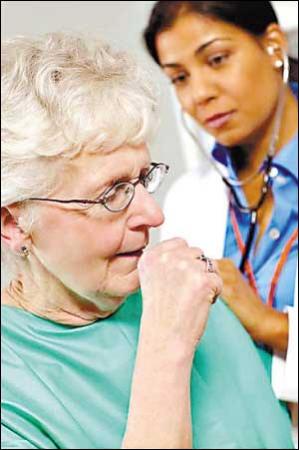据欧洲呼吸学会年会上报告的一项研究结果,H1N1流感住院患者中,哮喘患者的严重不良预后少于非哮喘患者;多变量分析显示,哮喘本身是H1N1流感住院患者严重不良预后减少的独立预测因子,该研究结果与近期对全球70,000例H1N1流感患者的分析结果一致,即哮喘与H1N1流感严重不良预后减少相关。

在该研究中, 英格兰利物浦大学的Malcolm Semple博士及其同事利用了英国卫生部于2009~2010年H1N1流感大流行时期资助的一项研究中的前瞻性队列数据。该队列用于向卫生部提供关于流行情况及临床特征的实时信息,标准化收集年龄、合并疾病、吸入性皮质激素的应用、症状发作至收入院的时间、以及住院期间使用药物和治疗等信息。这一队列包含收入英国75家医院的1,520例患者。如此大样本的研究在非疾病大流行的情况下是很难开展的。
研究者发现,哮喘患者在队列中占1/4(n=385),尽管入院时的肺炎发生率与非哮喘患者相似,但哮喘患者死亡或需重症监护的几率仅为非哮喘患者的一半(11.2% vs. 19.8%;未经校正比值比为0.51)。
研究者认为,3种变量——吸入性皮质激素的应用、在症状发作后4 d内收入院和全身应用皮质激素,均可看作是哮喘患者严重不良预后减少的原因。但在校正这3种变量后,单纯哮喘仍与死亡或重症监护几率降低45%相关(经校正OR为0.55)。使用吸入性皮质激素的哮喘患者死亡或需重症监护的几率(7.4%)显著低于未使用吸入性皮质激素者(15.4%)。另一方面,该研究显示,吸入性皮质激素仅对哮喘患者具有保护作用:约有1/5的患者因哮喘以外的原因接受吸入性皮质激素治疗,但这些患者未显示获益。这一结果不支持对于非哮喘患者使用吸入性皮质激素治疗。
研究者总结认为,哮喘与H1N1流感严重不良预后减少相关,但不良预后减少不能完全用使用吸入性皮质激素来解释。
这项研究由英国卫生部资助。研究者披露无相关利益冲突。
相关英文论文摘要:
Risk Factors for Severe Outcomes following 2009 Influenza A (H1N1) Infection: A Global Pooled Analysis
Background
Since the start of the 2009 influenza A pandemic (H1N1pdm), the World Health Organization and its member states have gathered information to characterize the clinical severity of H1N1pdm infection and to assist policy makers to determine risk groups for targeted control measures.
Methods and Findings
Data were collected on approximately 70,000 laboratory-confirmed hospitalized H1N1pdm patients, 9,700 patients admitted to intensive care units (ICUs), and 2,500 deaths reported between 1 April 2009 and 1 January 2010 from 19 countries or administrative regions—Argentina, Australia, Canada, Chile, China, France, Germany, Hong Kong SAR, Japan, Madagascar, Mexico, the Netherlands, New Zealand, Singapore, South Africa, Spain, Thailand, the United States, and the United Kingdom—to characterize and compare the distribution of risk factors among H1N1pdm patients at three levels of severity: hospitalizations, ICU admissions, and deaths. The median age of patients increased with severity of disease. The highest per capita risk of hospitalization was among patients <5 y and 5–14 y (relative risk [RR] = 3.3 and 3.2, respectively, compared to the general population), whereas the highest risk of death per capita was in the age groups 50–64 y and ≥65 y (RR = 1.5 and 1.6, respectively, compared to the general population). Similarly, the ratio of H1N1pdm deaths to hospitalizations increased with age and was the highest in the ≥65-y-old age group, indicating that while infection rates have been observed to be very low in the oldest age group, risk of death in those over the age of 64 y who became infected was higher than in younger groups. The proportion of H1N1pdm patients with one or more reported chronic conditions increased with severity (median = 31.1%, 52.3%, and 61.8% of hospitalized, ICU-admitted, and fatal H1N1pdm cases, respectively). With the exception of the risk factors asthma, pregnancy, and obesity, the proportion of patients with each risk factor increased with severity level. For all levels of severity, pregnant women in their third trimester consistently accounted for the majority of the total of pregnant women. Our findings suggest that morbid obesity might be a risk factor for ICU admission and fatal outcome (RR = 36.3).
Conclusions
Our results demonstrate that risk factors for severe H1N1pdm infection are similar to those for seasonal influenza, with some notable differences, such as younger age groups and obesity, and reinforce the need to identify and protect groups at highest risk of severe outcomes.
英文原文链接:https://www.plosmedicine.org/article/info%3Adoi%2F10.1371%2Fjournal.pmed.1001053







